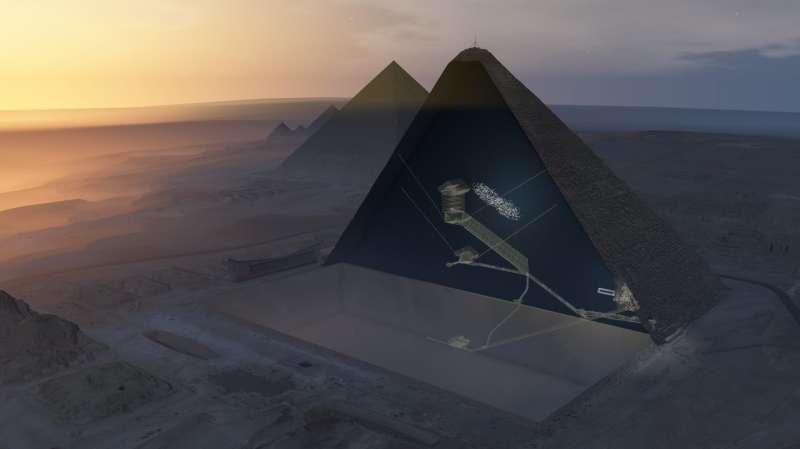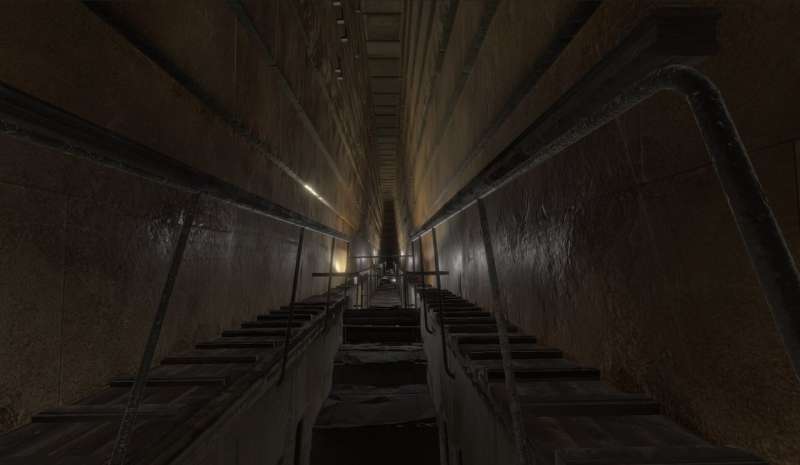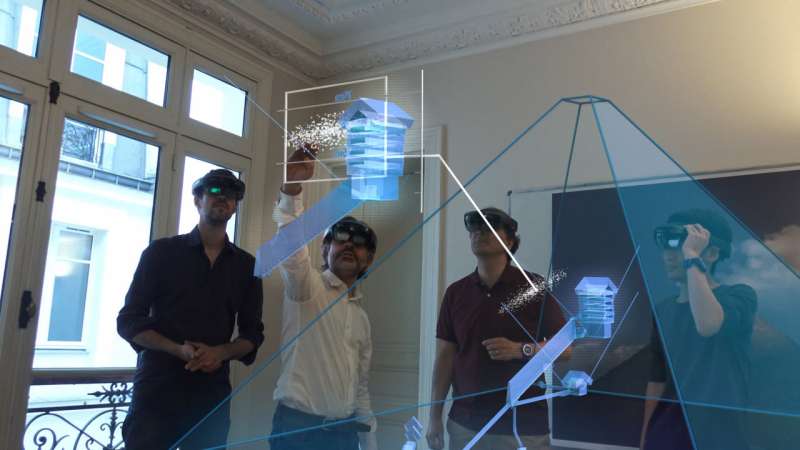Scientists discover hidden chamber in Egypt’s Great Pyramid

ScanPyramids Big Void 3D Artistic view horizontal option Credit: ScanPyramids mission
Scientists say they have found a hidden chamber in Egypt’s Great Pyramid of Giza, in what would be the first such discovery in the structure since the 19th century and one likely to spark a new surge of interest in the pharaohs.
In an article published in the journal Nature on Thursday, an international team said the 30-meter (yard) void deep within the pyramid is situated above the structure’s Grand Gallery, and has a similar cross-section.
The purpose of the space is unclear, and it’s not yet known whether it was built with a function in mind or if it’s merely a gap in the pyramid’s architecture. Some experts say such empty spaces have been known for years.
“This is a premier,” said Mehdi Tayoubi, a co-founder of the ScanPyramids project and president of the Heritage Innovation Preservation Institute. “It could be composed of one or several structures… maybe it could be another Grand Gallery. It could be a chamber, it could be a lot of things.”
The scientists made the discovery using cosmic-ray imaging, recording the behavior of subatomic particles called muons that penetrate the rock similar to X-rays, only much deeper. Their paper was peer-reviewed before appearing in Nature, an international, interdisciplinary journal of science, and its results confirmed by other teams of scientists.
Chances of the space containing treasure or burial chambers are almost nil, said Aidan Dodson, an Egyptologist at the University of Bristol, but the discovery helps shed light on building techniques.
“The pyramid’s burial chamber and sarcophagus have already been discovered, so this new area was more likely kept empty above the Grand Gallery to reduce the weight of stone pressing down on its ceiling,” he said, adding that similar designs have been found in other pyramids.
Egypt’s former antiquities minister and famed archaeologist Zahi Hawass, who has been testing scanning methods and heads the government’s oversight panel for the new techniques, said that the area in question has been known of for years and thus does not constitute a discovery. He has long downplayed the usefulness of scans of ancient sites.
“The Great Pyramid is full of voids. We have to be careful how results are presented to the public,” he said, adding that one problem facing the international team is that it did not have an Egyptologist as a member. He said the chamber was likely empty space builders used to construct the rooms below.

Khufu’s Pyramid 3D cut aerial view Credit: ScanPyramids mission
“In order to construct the Grand Gallery, you had to have a hollow, or a big void in order to access it—you cannot build it without such a space,” he said. “Large voids exist between the stones and may have been left as construction gaps.”
The pyramid is also known as Khufu’s Pyramid for its builder, a 4th Dynasty pharaoh who reigned from 2509 to 2483 B.C. Visitors to the pyramid, on the outskirts of Cairo, can walk, hunched over, up a long tunnel to reach the Grand Gallery. The space announced by the scanning team does not appear to be connected to any known internal passages.
Scientists involved in the scanning called the find a “breakthrough” that highlighted the usefulness of modern particle physics in archaeology.
“It was hidden, I think, since the construction of the pyramid,” Tayoubi added.

Known Grand Gallery Credit: ScanPyramids mission
The Great Pyramid, the last surviving wonder of the ancient world, has captivated visitors since it was built as a royal burial chamber some 4,500 years ago. Experts are still divided over how it and other pyramids were constructed, so even relatively minor discoveries generate great interest.
Late last year, for example, thermal scanning identified a major anomaly in the Great Pyramid—three adjacent stones at its base which registered higher temperatures than others.
Speculation that King Tutankhamun’s tomb contains additional antechambers stoked interest in recent years, before scans by ground-penetrating radar and other tools came up empty, raising doubts about the claim.
The muon scan is accomplished by planting special plates inside and around the pyramid to collect data on the particles, which rain down from the earth’s atmosphere. They pass through empty spaces but can be absorbed or deflected by harder surfaces, allowing scientists to study their trajectories and discern what is stone and what is not. Several plates were used to triangulate the void discovered in the Great Pyramid.

ScanPyramids team Augmented reality review of ScanPyramids Big Void Credit: ScanPyramids mission
While the technology can detect large open spaces, it cannot discern what is inside, so it’s unclear if the empty space contains any objects. Tayoubi said the team plans now to work with others to come up with hypotheses about the area.
“The good news is that the void is there, and it’s very big,” he said.

Related Post
A shocking documentary proves that mermaids do exist
SHOCKING Revelation: Thuya, Mother of Queen Tiye, Was the Grandmother of Akhenaten and Tutankhamun—What Ancient Egyptian Secrets Did She Leave Behind?
Breaking News: Astonishing Discoveries at Karahan Tepe Confirm an Extraterrestrial Civilization is Hiding on Earth, and NO ONE Knows!
Breaking News: Researchers FINALLY Discover U.S. Navy Flight 19 After 75 Years Lost in the Bermuda Triangle!
NASA’s Secret Investigation: Uncovering the Astonishing Mystery of the UFO Crash on the Mountain!
Explosive UFO Docs LEAKED: Startling Proof That Aliens Ruled Ancient Egypt!